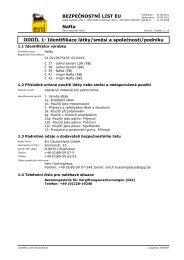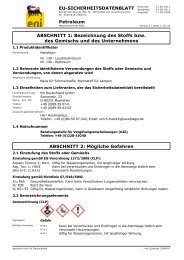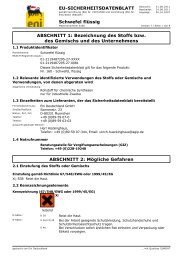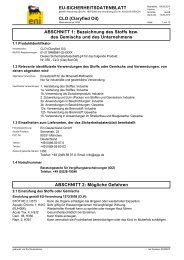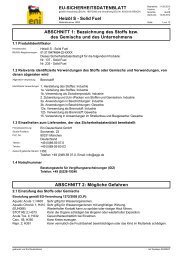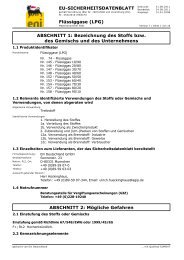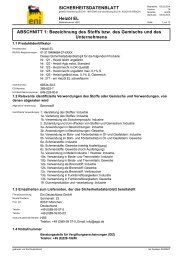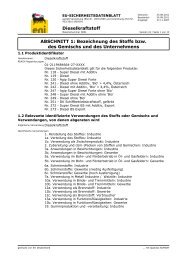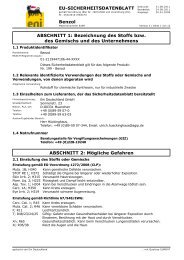- Page 1 and 2:
EU-SICHERHEITSDATENBLATT gemäß Ve
- Page 3 and 4:
EU-SICHERHEITSDATENBLATT gemäß Ve
- Page 5 and 6:
EU-SICHERHEITSDATENBLATT gemäß Ve
- Page 7 and 8:
EU-SICHERHEITSDATENBLATT gemäß Ve
- Page 9 and 10:
EU-SICHERHEITSDATENBLATT gemäß Ve
- Page 11 and 12:
EU-SICHERHEITSDATENBLATT gemäß Ve
- Page 13 and 14:
EU-SICHERHEITSDATENBLATT gemäß Ve
- Page 15 and 16:
Vacuum Gas Oils, Hydrocracked Gas O
- Page 17 and 18:
Vacuum Gas Oils, Hydrocracked Gas O
- Page 19 and 20:
Vacuum Gas Oils, Hydrocracked Gas O
- Page 21 and 22:
Vacuum Gas Oils, Hydrocracked Gas O
- Page 23 and 24:
Vacuum Gas Oils, Hydrocracked Gas O
- Page 25 and 26:
Vacuum Gas Oils, Hydrocracked Gas O
- Page 27 and 28:
Vacuum Gas Oils, Hydrocracked Gas O
- Page 29 and 30:
Vacuum Gas Oils, Hydrocracked Gas O
- Page 31 and 32:
Vacuum Gas Oils, Hydrocracked Gas O
- Page 33 and 34:
Vacuum Gas Oils, Hydrocracked Gas O
- Page 35 and 36:
Vacuum Gas Oils, Hydrocracked Gas O
- Page 37 and 38:
Vacuum Gas Oils, Hydrocracked Gas O
- Page 39 and 40:
Vacuum Gas Oils, Hydrocracked Gas O
- Page 41 and 42:
Vacuum Gas Oils, Hydrocracked Gas O
- Page 43 and 44:
Vacuum Gas Oils, Hydrocracked Gas O
- Page 45 and 46:
Vacuum Gas Oils, Hydrocracked Gas O
- Page 47 and 48:
Vacuum Gas Oils, Hydrocracked Gas O
- Page 49 and 50:
Vacuum Gas Oils, Hydrocracked Gas O
- Page 51 and 52:
Vacuum Gas Oils, Hydrocracked Gas O
- Page 53 and 54:
Vacuum Gas Oils, Hydrocracked Gas O
- Page 55 and 56:
Vacuum Gas Oils, Hydrocracked Gas O
- Page 57 and 58:
Vacuum Gas Oils, Hydrocracked Gas O
- Page 59 and 60:
Vacuum Gas Oils, Hydrocracked Gas O
- Page 61 and 62:
Vacuum Gas Oils, Hydrocracked Gas O
- Page 63 and 64:
Vacuum Gas Oils, Hydrocracked Gas O
- Page 65 and 66:
Vacuum Gas Oils, Hydrocracked Gas O
- Page 67 and 68:
Vacuum Gas Oils, Hydrocracked Gas O
- Page 69 and 70:
Vacuum Gas Oils, Hydrocracked Gas O
- Page 71 and 72:
Vacuum Gas Oils, Hydrocracked Gas O
- Page 73 and 74:
Vacuum Gas Oils, Hydrocracked Gas O
- Page 75 and 76:
Vacuum Gas Oils, Hydrocracked Gas O
- Page 77 and 78:
Vacuum Gas Oils, Hydrocracked Gas O
- Page 79 and 80:
Vacuum Gas Oils, Hydrocracked Gas O
- Page 81 and 82:
Vacuum Gas Oils, Hydrocracked Gas O
- Page 83 and 84:
Vacuum Gas Oils, Hydrocracked Gas O
- Page 85 and 86:
Vacuum Gas Oils, Hydrocracked Gas O
- Page 87 and 88:
Vacuum Gas Oils, Hydrocracked Gas O
- Page 89 and 90:
Vacuum Gas Oils, Hydrocracked Gas O
- Page 91 and 92:
Vacuum Gas Oils, Hydrocracked Gas O
- Page 93 and 94:
Vacuum Gas Oils, Hydrocracked Gas O
- Page 95 and 96:
Vacuum Gas Oils, Hydrocracked Gas O
- Page 97 and 98:
Vacuum Gas Oils, Hydrocracked Gas O
- Page 99 and 100:
Vacuum Gas Oils, Hydrocracked Gas O
- Page 101 and 102:
Vacuum Gas Oils, Hydrocracked Gas O
- Page 103 and 104:
Vacuum Gas Oils, Hydrocracked Gas O
- Page 105 and 106:
Vacuum Gas Oils, Hydrocracked Gas O
- Page 107 and 108:
Vacuum Gas Oils, Hydrocracked Gas O
- Page 109 and 110:
Vacuum Gas Oils, Hydrocracked Gas O
- Page 111 and 112:
Vacuum Gas Oils, Hydrocracked Gas O
- Page 113 and 114:
Vacuum Gas Oils, Hydrocracked Gas O
- Page 115 and 116:
Vacuum Gas Oils, Hydrocracked Gas O
- Page 117 and 118:
Vacuum Gas Oils, Hydrocracked Gas O
- Page 119 and 120:
Vacuum Gas Oils, Hydrocracked Gas O
- Page 121 and 122: Vacuum Gas Oils, Hydrocracked Gas O
- Page 123 and 124: Gas Oils (Vacuum) 4 DNEL (inhalatio
- Page 125 and 126: Industrial - Tabletting, CS100 Indo
- Page 127 and 128: Combined Professional - Manual spra
- Page 129 and 130: Industrial - Bulk transfers CS14 Da
- Page 131 and 132: Professional - Maintenance and CS77
- Page 133 and 134: Note: differentiated Industrial -SU
- Page 135 and 136: Professional - Treatment and dispos
- Page 137 and 138: Industrial - operation of open CS16
- Page 139 and 140: Vacuum Gas Oils, Hydrocracked Gas O
- Page 141 and 142: Vacuum Gas Oils, Hydrocracked Gas O
- Page 143 and 144: Vacuum Gas Oils, Hydrocracked Gas O
- Page 145 and 146: Gas Oils (Vacuum) 4 DNEL (inhalatio
- Page 147 and 148: Industrial - Tabletting, CS100 Indo
- Page 149 and 150: Combined Professional - Manual spra
- Page 151 and 152: Industrial - Bulk transfers CS14 Da
- Page 153 and 154: Professional - Maintenance and CS77
- Page 155 and 156: Note: differentiated Industrial -SU
- Page 157 and 158: Professional - Treatment and dispos
- Page 159 and 160: Industrial - operation of open CS16
- Page 161 and 162: Vacuum Gas Oils, Hydrocracked Gas O
- Page 163 and 164: Vacuum Gas Oils, Hydrocracked Gas O
- Page 165 and 166: This tool is provided for informati
- Page 167 and 168: An Evaluation of the Persistence, B
- Page 169 and 170: Table of Contents Executive Summary
- Page 171: 2.0 Outline of PBT/vPvB Assessment
- Page 175 and 176: 100.0 Half-life predicted (days) 10
- Page 177 and 178: 2,3-dimethylheptane 9 7.7 6.2 7.4 2
- Page 179 and 180: ioHCwin half-life (days) 10000.0 10
- Page 181 and 182: criterion. It can be concluded that
- Page 183 and 184: ioHCwin half-life (days) 100000.0 1
- Page 185 and 186: Hydrocarbon C nr BioHCwin Predicted
- Page 187 and 188: ioHCwin half-life (days) 1000000.0
- Page 189 and 190: ioHCwin half-life (days) 1000.0 100
- Page 191 and 192: Hydrocarbon C nr BioHCwin Predicted
- Page 193 and 194: enzo[a]pyrene 20 421.6 16.5 Table 1
- Page 195 and 196: (see Appendix 2). Since BCF predict
- Page 197 and 198: 10000 BCF (Arnot) 1000 100 10 1 n-P
- Page 199 and 200: exhibit BMFs near unity (Figure 28)
- Page 201 and 202: 2,2,4,4,6,8,8- heptamethyl nonane 1
- Page 203 and 204: Hydrocarbon C BMF BCF (Arnot) Dieta
- Page 205 and 206: BCF (regression) 100000 10000 1000
- Page 207 and 208: 4.5 Polynaphthenic hydrocarbons Reg
- Page 209 and 210: Experimental BMF 10 1 Polynaphth. D
- Page 211 and 212: enzene n-octylbenzene 14 0.034 403
- Page 213 and 214: 10000 1000 BCF (Arnot) 100 10 1 NMA
- Page 215 and 216: and appears to be an outlier. This
- Page 217 and 218: 4-ethylbiphenyl 14 863 1039 C Yakat
- Page 219 and 220: 100000 BCF (regression) 10000 1000
- Page 221 and 222: 10 Experimental BMF 1 0.1 NDiAr Die
- Page 223 and 224:
Hydrocarbon C BMF Arnot BCF Dietary
- Page 225 and 226:
Hydrocarbon C BMF Arnot BCF Dietary
- Page 227 and 228:
Acenaphthene Acenaphthylene Benz(a)
- Page 229 and 230:
5.0 Summary of Persistence and Bioa
- Page 231 and 232:
lower water solubility, it is possi
- Page 233 and 234:
properties of petroleum hydrocarbon
- Page 235 and 236:
8.0 References Anonymous (2004). Fi
- Page 237 and 238:
EMBSI (2007c). Fish, dietary bioacc
- Page 239 and 240:
Prince RC, Walters CC. (2007). Biod
- Page 241 and 242:
Appendix 1. Hydrocarbon structures
- Page 243 and 244:
iP 14 2,4,10-Trimethylundecane CC(C
- Page 245 and 246:
MN 7 1,2-Dimethylcyclopentane CC1C(
- Page 247 and 248:
MN 14 n-Nonylcyclopentane CCCCCCCCC
- Page 249 and 250:
MN 29 MN 29 MN 30 n-Tetracosylcyclo
- Page 251 and 252:
hexahydroindane DN 20 2,4-dimethylo
- Page 253 and 254:
PN 27 Phenanthrene 2,6-dimethylhept
- Page 255 and 256:
MAr 13 1-Methyl-3-hexylbenzene Cc1c
- Page 257 and 258:
NMAr 12 n-Propylindan c1ccc2CC(CCC)
- Page 259 and 260:
NMAr 24 c1cc(CC(C)CCCC(C)CCCCC)c2CC
- Page 261 and 262:
NMAr 29 NMAr 29 NMAr 29 NMAr 29 NMA
- Page 263 and 264:
DAr 16 2-Hexylnaphthalene CCCCCCc1c
- Page 265 and 266:
NDAr 16 n-Butylacenaphthene c12cccc
- Page 267 and 268:
NDAr 26 Dimethyloctyl-1,2,3,6,7,8-
- Page 269 and 270:
PAr 19 Ethylbenzo(a)fluorene C3c1cc
- Page 271 and 272:
PAr 22 n-Pentylbenzo(a)fluorene C3c
- Page 273 and 274:
PAr 28 Isohexyl-octadecahydro-picen
- Page 275 and 276:
Appendix 3. CONCAWE Position Paper
- Page 277 and 278:
probabilities are adjusted to best
- Page 279 and 280:
1.2.2 OASIS LMC Models: Toxicologic
- Page 281 and 282:
environmental chemicals (database o
- Page 283 and 284:
dihydrodiol. These dihydroxylated i
- Page 285 and 286:
Table 1 : PBT assessment of C15 str
- Page 287 and 288:
1: The following structures were pr
- Page 289 and 290:
Dimitrov SD, Dimitrova N, Mekenyan
- Page 291 and 292:
hydrocarbons and azaarenes original
- Page 293 and 294:
Verhaar HJM, van Leeuwen CJ, Hermen
- Page 295 and 296:
CONCAWE AQUATIC TOXICITY PREDICTION
- Page 297 and 298:
CONTENTS (Continued) Section Page 1
- Page 299 and 300:
1-2 The model predictions include m
- Page 301 and 302:
2-1 SECTION 2 2 SUMMARY OF COMPOSIT
- Page 303 and 304:
4-1 SECTION 4 4 SUMMARY OF COMPOSIT
- Page 305 and 306:
6-1 SECTION 6 6 SUMMARY OF COMPOSIT
- Page 307 and 308:
8-1 SECTION 8 8 SUMMARY OF COMPOSIT
- Page 309 and 310:
10-1 SECTION 10 10 SUMMARY OF COMPO
- Page 311 and 312:
12-1 SECTION 12 12 SUMMARY OF COMPO
- Page 313 and 314:
14-1 SECTION 14 14 SUMMARY OF COMPO
- Page 315 and 316:
16-1 SECTION 16 16 SUMMARY OF COMPO
- Page 317 and 318:
18-1 SECTION 18 18 SUMMARY OF COMPO
- Page 319:
20-1 SECTION 20 20 SUMMARY OF COMPO




